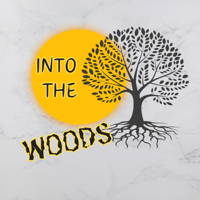
Overview
Synopsis
“Be careful what you wish for” seems to be the ongoing theme in Stephen Sondheim and James Lapine’s Brothers Grimm inspired musical, Into the Woods. The story follows The Baker and his wife who wish to have a child, Cinderella who wishes to go the King’s Festival, and Jack who wishes his cow would give some milk. When the Baker and his wife are visited by the neighborhood witch, who reveals to them that she placed a curse on their family, the two set off on a journey into the woods to reverse the curse. Also in the woods, we meet Little Red, who is trying to visit her grandmother, the Wolf who loves tasty little girls, the Witch’s daughter Rapunzel, and the Princes chasing after their loves. By the end of Act One, everyone has gotten their wish and will seemingly live happily ever after. But in Act Two, when Jack’s beanstalk brings them a visit from an angry Giant, we see how the consequences of their actions haunt them in disastrous ways. The community must come together to save each other and their kingdom, but sacrifices must be made.
Show Information
Context
Show Origins
Inspired by the Brothers Grimm Fairy Tales, including Little Red Riding Hood, Rapunzel, and Jack and the Beanstalk, Stephen Sondheim and James Lapine set out to create a story centering around the moral struggles of these famous characters. Initially, Sondheim wanted to write a “quest” musical, while Lapine was focused on writing a fairytale. The idea of creating a fairytale mashup was inspired by a television show the duo pitched which featured characters from different
to read the context for Into the Woods and to unlock other amazing theatre resources!Plot
Act One
At the top of the show, we are introduced to four characters, each with his/her own wish: Cinderella, who is cleaning, wishes with all her heart that she might be able to attend the King’s Festival; Jack, who is trying to milk his sad, dry cow Milky-White, wishes that she would start producing milk again, so she wouldn’t have to be sold at market; and the Baker and his wife wish with all their hearts for a child. The Narrator leads the company in setting up the circumstances (Act
to read the plot for Into the Woods and to unlock other amazing theatre resources!Characters
| Name | Part Size | Gender | Vocal Part |
|---|---|---|---|
|
Lead |
Male |
Tenor |
|
|
Lead |
Female |
Mezzo-Soprano |
|
|
Lead |
Male |
Baritone |
|
|
Lead |
Female |
Mezzo-Soprano |
|
|
Lead |
Female |
Mezzo-Soprano, Alto |
|
|
Lead |
Female |
Soprano |
|
|
Supporting |
Male |
Bass-Baritone |
|
|
Supporting |
Female |
Mezzo-Soprano |
|
|
Supporting |
Female |
Mezzo-Soprano |
|
|
Supporting |
Female |
Mezzo-Soprano |
|
|
Supporting |
Female |
Soprano |
|
|
Supporting |
Male |
Baritone |
|
|
Supporting |
Either Gender |
Baritone |
|
|
Supporting |
Female |
Soprano |
|
|
Supporting |
Male |
Bass-Baritone |
|
|
Supporting |
Either Gender |
Silent |
|
|
Supporting |
Female |
Spoken |
|
|
Featured |
Female |
Soprano |
|
|
Featured |
Male |
Baritone |
|
|
Featured |
Male |
Spoken |
Songs
Act One
Act Two
A song with an asterisk (*) before the title indicates a dance number.
Monologues
Scenes
Key Terms
A low female vocal range used in opera and musical theatre, often assigned to mature or dramatic roles.
A male vocal range between tenor and bass, often used for romantic leads, villains, or father figures in opera and musicals.
The lowest male vocal range, typically associated with characters of authority, wisdom, or villainy in opera and musicals.
A powerful, resonant singing technique used in musical theatre to project high notes with chest voice.
In musical theatre, the script or spoken text of the show, not including the music or lyrics.
A combination of musical notes played simultaneously, forming harmony.
A musical style that uses notes outside the key to create tension and color.
In theatre, refers to the collective of artists, audience, and supporters, or to a type of amateur or local theatre.
A spoken or symbolic expression of ill will, often used in drama to introduce supernatural or emotional conflict.
A combination of tones that creates tension or a lack of harmony, often used for dramatic effect.
A genre of story involving magical and fantastical elements, sometimes adapted for theatrical performance.
A male vocal range above baritone, commonly featured in opera and musical theatre for romantic or heroic lead characters.
Videos
Quizzes
Themes, Symbols & Motifs
THEMES
Wishes and Desires
Cinderella opens
to read about the themes, symbols and motifs from Into the Woods and to unlock other amazing theatre resources!Quote Analysis
*Sometimes people leave you
Halfway through the


